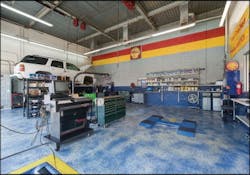George's Sierra Shell
SHOP: George’s Sierra Shell LOCATION: Fontana, Calif. OWNER: Doug Whiteman SIZE: 1,200 square feet
STAFF: 7 MONTHLY CAR COUNT: 220 a month ANNUAL REVENUE: $1.1 million
1) George’s Sierra Shell, a full-service gas station, pulled in more than $1 million in sales in 2012 from its three-bay shop. While owner Doug Whiteman credits a lot of the success to effective teamwork, he says the appearance of the shop floor—which was rebuilt in 1996—has been vital to success. The front office waiting area contains windows that look directly into the shop, which encourages the staff to constantly keep the area clean and polished. .
2) The shop floor is only 1,200 square feet, so organization is key to keep it from looking cluttered. Whiteman says he keeps tight control of the inventory, and only stores filters, oil, coolant and cleaners on the shelves in the shop. “If we haven’t used it in the last six months, we either sell it, junk it or store it,” he says.
3) The floor is painted with gray epoxy-based paint with blue flakes that provide resistance and keep the floor from getting slippery. Whiteman says that up until a year ago, the floor was just painted with a product from The Home Depot that chipped easily and forced the shop to close down for a few days every couple of years for a repaint. To save money in the long run, Whiteman decided to upgrade to the more durable coating.
4) Upon rebuilding the shop in 1996, Whiteman selected in-ground pad lifts that swivel 360 degrees. Not only do they easily get the cars up in the air, but the in-ground lifts also take up less space on the already tight shop floor.
5) After attending an Automotive Training Institute shop management course, Whiteman started investing more heavily in the software used in the shop. The shop floor is equipped with five NAPA workstations that use NAPA Tracs, and the computers also use Mitchell 1 ProDemand.
6) Each bay serves its own unique purpose, so the technicians keep their toolboxes directly next to the bay. While the first bay is used for lighter duty repair, the second is for medium-to-light duty and the farthest bay is used for bigger jobs. “We don’t want to be running back and forth for toolboxes,” Whiteman says. “If techs have a workbench full of tools, they’re just turning around and grabbing what they need.”
